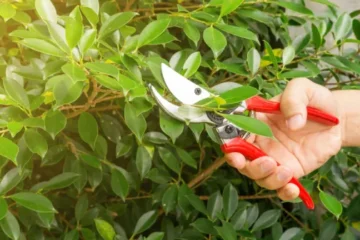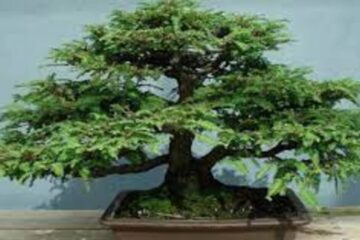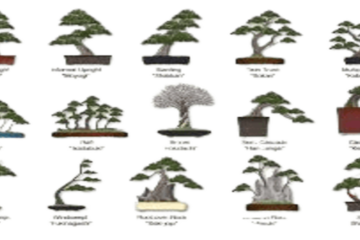A Japanese maple tree can add an interesting focal point to your landscaping, but if you’re like most people, you aren’t an expert on the species and don’t know how to trim one correctly. If that’s the case, check out this guide on how to trim a Japanese maple! You’ll be able to give your tree the healthy shape it needs with minimal effort and fuss in no time at all.
Japanese maples are striking landscape trees that offer lasting color throughout the year. Some Japanese maples can only reach 6 to 8 feet by 1.5 to 2 m. , but others will reach 40 ft. 12m Oh more. You seldom need to prune mature Japanese Maple trees if they have been well trained while young.
During the early years of the tree’s life, a light trim shapes a graceful, woody skeleton. Get familiar with the art of pruning a Japanese maple so you can shape the gorgeous leaves of this wondrous tree.
Why Trim Japanese Maple?
Content Overview
Pruning can be carried out for the health of the tree, or it can be done in order to better preserve the aesthetic look of the tree.
Direct Growth and Structure: Through trimming, you can alter the natural growth habits of the tree and influence the way it grows.
Improve Airflow: The increased airflow from the branches decreases the risk of getting diseases.
Removal of dead, diseased, or damaged branches: Remove dead, broken, or diseased branches as the top priority for a healthy tree.
Prevent Unwanted Growth: If a branch is protruding onto power lines, on the roof, or in any unwanted places, it should be cut back.
Reduce weight: In order to lighten the load of an overloaded branch, simply trim the ends of it.
Japanese Maple Tree Pruning
Japanese maple is a deciduous tree used as an ornamental plant for shading. While established plants that get little light and are protected from strong winds don’t need too much care. The care for Japanese maples is so minimal that they can be maintained with no problems, making them an excellent tree to have in most gardens.
Many trees have low, inviting canopy or ones that are also tall and sharply angled with weeping willow branches. Whatever type of Japanese maple you have, it is recommended to cut lightly under the branches for access as the branches shed as the plant matures and the heavy branches can grow too low and even put pressure on the rest of the tree.
How to train a Japanese Maple?
For a Japanese maple, follow these instructions to train your tree:
Before you begin training your Japanese maple, make sure it is located within a suitable growing environment. Japnese maples thrive best in full sun and well-drained soil. Check with a local nursery to confirm that your tree will survive and grow in its new location.
Once you have confirmed that your tree will thrive in its new home, start by using binder clips or string to tie down all of your tree’s branches to stakes or any other structure around your yard. This process should be done during summer when growth slows down for Japanese maples.
Once you have successfully secured all of your tree’s branches, continue by trimming back any branches that are low on wood. These will not be suitable for producing blooms or displaying fall colors in autumn.
In addition, cut out any dead branches and make small pruning cuts to remove branches growing toward the center. This will help direct sunlight and air into your Japanese maple’s canopy and encourage growth from within its central structure. Finally, secure any large lateral limbs using wrapping tape or rope.
When to Trim or Prune a Japanese Maple?
The Japanese maple is a plant of temperate mountain climate. It lives in regions with generally mild summers and very cold winters, covering the landscape with snow. With these conditions, what the tree does is grow in spring and summer, to go into rest in autumn and winter.
For this reason, the time of pruning is at the end of winter, when the buds are about to wake up (that is, to increase in size, to “swell”). Thus, the wounds that we will produce will heal quickly, since as the plant is resuming its growth, sap will circulate through its branches somewhat faster.
There are few rules about how to trim a Japanese maple. You should trim a Japanese maple in late winter or early spring. Japanese maples are not cut during this resting period, meaning fewer injuries are inflicted during that time.
For the most part, pruning Japanese maples is limited to removing dead branches and thin stems, which clog the beautiful skeleton of the tree. Young trees need to have lower branches cut to improve clear visibility.
Train the tree when it is a little younger, at the age of two or three. Remove limbs that rub against each other or are too close together. To get a better-looking tree, use sharp pruning shears and cut twigs and small branches within it.
What tools need for Trimming Japanese Maple?
Bonsai Clippers vs Bonsai Scissors is the best for trimming Japanese maple trees. You will need a pruning shear or other tool to trim your Japanese maple. A saw will also come in handy if you want to take off extra branches. You might need a ladder if you plan on doing any trimming high up on your tree, and gloves will protect your hands from sharp edges and thorns. Depending on how much of your Japanese maple you want to cut, you may also need scissors and clippers as well.
You’ll also need containers for each of your plants. These containers should have holes that are large enough for water and fertilizer runoff. If you can, use old toilet paper rolls with holes drilled in them as your plant holders. They’re cheap and easy to make, and if you don’t want them anymore, it will be very easy to toss them out. You can find toilet paper rolls at any dollar store for less than $1 per roll.
What do You have to Know Before Trimming a Japanese Maple tree?
To trim a Japanese maple, first of all, you have to know that the plant in question has to be healthy, or at least strong enough to be able to withstand these prunings. We must think that with each cut we make, the Japanese maple will spend energy to close that wound, and if we can one that is already weak, we risk that it will not overcome it.
In addition, it is also important to use proper pruning tools in front of you and to clean them with dishwashing soap and water before and after use. They are the following:
Domestic scissors: Domestic scissors such as kitchen scissors for example) for green branches with a thickness of 0.5 centimeters or less. Buy them here.
Anvil Shears for green branches about 1 cm thick. for sale here.
Hand saw for woody ones with a thickness of 2 centimeters or more. You can buy them from this link.
How to trim Japanese Maple Step by Steps Guides:
If you want to trim a Japanese Maple You must have followed the below steps:
Trimming a Maple
On non-Japanese maples, pruning is done in the shape of an egg.
To do this, cut the high branches about halfway, then cut the low branches to clear the trunk.
Trim to Remove Dead Branches
While trimming should be done frequently to maintain your tree’s shape, it is best to avoid pruning in winter when branches and stems are bare.
Use pruning shears to remove dead branches and twigs. Alternatively, you can remove them with garden loppers or a pair of sharp pruners.
Dead branches are easily identified by their gray, brown, or black color and brittle appearance. If you see any of these signs, prune them off immediately with bypass pruners or loppers.
In addition to removing dead limbs, use your trimming sessions to remove long branches that are out of proportion with others on your tree.
You can also take note of areas where branches grow close together so you know where it may be necessary to thin out some future growth.
Know Which Branches to Cut
It’s not always easy to know which branches to cut, especially since some of them appear dead. You can check by feeling for wind knots—small bumps where two or more branches have overlapped and grown together. If there are wind knots on your tree, you can sometimes snip away at these areas safely.
How do you know which branches on your tree need trimming?
You’ll need to look at it from above and below, but even then it can be difficult because all of its foliage looks green. To make sure you don’t mistakenly snip something off that doesn’t require it, spend some time studying your tree. The most important thing is that you know what’s dead—it should snap rather than bend if you try to bend it.
Where and How Much to Cut Back?
The overall shape of your tree will largely be determined by its original training, but you’ll need to prune off any shoots that have grown into undesirable places.
First, use sharp bypass loppers or pruning shears to cut out any branches coming from lower down on your trunk; these need not be removed entirely unless they are crossing over other branches and growing into them.
Next, look up at your tree. Are there any branches you’d like to remove entirely? Bypass loppers are good for larger cuts, while smaller branches can be trimmed with pruning shears. Again, don’t worry about removing all branches; just trim them back so they grow outward.
When you trim back a branch?
Cut about one-third of its length. After each session of pruning, you’ll want to make sure your tree has plenty of water (at least one gallon per inch of trunk diameter) and at least two hours of direct sunlight. Learn about how to water your bonsai tree?
If there are any branches that came from higher up on your trunk and you removed them earlier, it’s time to consider some shape training. The method we’ll be using here is bending.
The idea is to train your tree so its branches grow outward, rather than upward and inward. To do that, all you need is a stout piece of cardboard, two pieces of wire, and some ties.
First, wrap one piece of wire around an upper branch you’d like to train (we’ll start with something simple), then tie it down with some pruning tape or string. Do the same thing at eye level on another branch.
Trim Upright Japanese maples
Why choose an upright Japanese maple? They are best suited for small yards, apartments, and patios or low-maintenance landscaping. These trees grow tall but narrow with multiple trunks.
Because they generally don’t spread laterally as their cousins do, they have fewer limbs that need to be pruned each year. Choose one that has been trimmed at least once already by an arborist; you can find these trees online or at your local home improvement store.
The Japanese maple grows straight and slender, making it a perfect choice for bordering fences, patio borders, or on one side of an entrance.
The tree grows best where summers are warm and winters are cool, so gardeners in regions such as South Florida, Texas, and Arizona should consider an alternative tree.
Japanese Maple Shaping Pruning
It is quite easy to trim a purple or green Japanese maple into any shape imaginable. For this reason, it is a very suitable tree for the creation of bonsai.
If you wish to have, in the garden or in a pot, a tree limited to a certain height, it is best to choose a variety that will not be much taller than the desired size.
The number of varieties of Japanese maple makes it easy to find one that will suit. With Japanese maple cloud pruning is possible.
It is necessary to start from an already large tree, at least ten years old, and then clear the branches in order to leave space between small “bushes” of leaves.
If necessary, as for bonsais, it is possible to tie or weight the branches to make them take the desired shape.
Aesthetic pruning of Japanese maples
Aesthetic pruning of Japanese maple is performed during spring and summer to remove dead, diseased, and damaged wood and control the overall size of the tree.
Aesthetic pruning involves removing dead branches, as well as shorter limbs, which produce fewer leaves and show less detail than longer limbs. The goal of the aesthetic pruning of a Japanese Maple is to create an attractive tree that has strong design lines throughout its structure.
Aesthetic pruning, also known as design pruning, has many goals and takes into account many factors. Pruning at improper times or for incorrect reasons can cause significant damage to a tree’s structure, health, and overall beauty.
A well-designed tree allows light and air movement through its structure, with branches that spread away from each other rather than growing towards each other. The best candidates for aesthetic pruning are bonsai-quality trees, which have been carefully cultivated from an early age.
As stated above, the aesthetic pruning of Japanese maples has many goals. However, some of these goals differ depending on whether you’re working with a mature or young tree.
Whether your goal is to reduce overall size, increase ramification (branching), improve taper (the tapering of limbs towards the trunk), or highlight particular characteristics of your tree, knowing how best to prune your tree will ensure that you achieve success.
Aesthetic pruning has many goals, but one of its most important is improving air movement through your tree’s structure. Branches should be spread away from each other instead of growing towards each other, with at least 2-3′ between branches when viewed from above.
Young trees benefit from regular aesthetic pruning (at least once per year) until they are about 7-10 years old and have achieved about two or three sets of true leaves.
Japanese Maple Clump Pruning
For medium-tall Japanese maples, a clump pruning is generally carried out, that is to say with several trunks separating at the base.
To do this, it is necessary to prune the major branches of the center to favor those which go outwards.
Japanese Maple Maintenance Pruning
For the maple as for all non-fruit trees, it is important to prune the damaged parts, which could be the gateway to future disease, as well as the deadwood and dry branches, which could by friction due to the wind cause injuries to the rest of the crown.
Pruning large maple trees
It’s important to understand that pruning large trees can be quite dangerous, so if you have one of these giants on your property, consider hiring an arborist for any pruning needs. However, here are some tips for trimming smaller maples (usually between 2 and 6 feet tall).
Begin by getting all your tools together. The most common tool is pruning shears or loppers; pick whichever feels more comfortable in your hand.
If you do find yourself trimming large maple trees, your first step is going to be finding some fall protection. Make sure you have at least one other person on hand, as well as safety glasses and hard-soled shoes.
Then stand back and evaluate what branch needs pruning by looking at how it grows toward its neighbors. This will help you decide where you want your cut to go.
If you find yourself pruning large maple trees, you will need a few additional tools. A chain saw is going to be your best bet, as it’s able to slice through wood that your loppers can’t even get near.
But even with these steps, if you’re in doubt about your abilities, it’s best not to prune such large branches on your own.
Laceleaf Japanese maples

Japanese maples (Acer palmatum) are among some of the most popular evergreens for gardeners. Some of their most beautiful cultivars, however, like laceleaf Japanese maples, can be particularly tricky to trim and shape.
As their name suggests, laceleaf Japanese maples feature deeply cut leaves that resemble lacy doilies. They’re beautiful trees, but it can be hard to trim them correctly.
To keep your tree balanced and symmetrical, follow these simple steps for how to trim a laceleaf Japanese maple.
These are some of my favorite trees. They’re gorgeous and really stand out from other maples. The only drawback is that they can be extremely temperamental to trim properly, so here’s a simple guide to help you prune your laceleaf Japanese maple tree into shape.
Frequently Answer the Questions?
When to prune maple?
Pruning is theoretically practiced between November and February, however, the sap rising very early, it is preferable to avoid pruning after December. Pruning is not done every year, but every 3 to 5 years maximum, depending on the development of the tree.
How tall is a maple?
The maple is a tree of the Aceraceae family. Maples are trees generally between 10 and 40 meters high (like the sycamore maple or the Montpellier maple), but some species that do not reach these heights are called shrubs, such as the Japanese maple by example.
How to keep a Japanese maple small?
By adding a “Vermicompost” organic fertilizer each winter, you will keep your maple healthy and grow harmoniously. Container-grown Japanese maples should be watered regularly, but not excessively.
How to prune a young Japanese maple?
It consists of cutting the young maple 30cm above the collar so that new branches appear and thus give a beautiful stump shape. Each of these branches must then be pruned so that it can take on thickness.
When to prune acers?
Pruning is theoretically practiced between November and February, however, the sap rising very early, it is preferable to avoid pruning after December. Pruning is not done every year, but every 3 to 5 years maximum, depending on the development of the tree.
In Summary, If you want to trim your Japanese maple tree, you need to start by pruning away dead or diseased branches. You can do so at any time of year, but spring is best because it will give new growth a chance to harden off before winter. Then, use sharp hand pruners or loppers and remove branches that are rubbing against each other.



